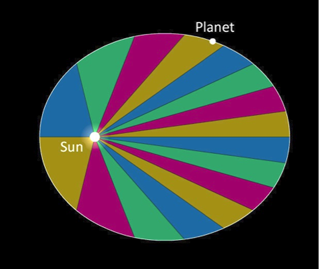Forces and Motion
Equation
P2 ~ a3
1.15
Teachers’ Guide* to Kepler’s Laws:
http://www-spof.gsfc.nasa.gov/stargaze/Kep3laws.htm
*great for students, too!
Kepler's 3rd Law:
P2 ~ a3
(the square of the period, p, is proportional to the cube of the semi major axis, a, which is the average distance of an object from the Sun).
 Left: Illustration captured from UNL Planetary Orbit Simulator
Left: Illustration captured from UNL Planetary Orbit Simulator
Kepler’s third law attempts to quantify planetary motion. The law as written here applies to all orbiting objects (e.g. satellites around the Earth, moons around Jupiter, double star systems). The “ ~ ” means “is proportional to”. It turns out that if we use the right units of measure, in this case years for P and AU for a, then we can replace the “ ~ ” with an “=” sign when calculating planetary orbits in our own solar system. In the diagram above Kepler’s 3rd Law is plotted for M, V, E and M again - the planets Mercury, Venus, Earth and Mars. Mars has a period of 1.88 years (that is how long it takes to go around the Sun one time) and the distance is measured in astronomical units (1 AU equals the distance from Earth to the Sun, about 150,000,000 km). Mars is 1.52 AU from the Sun.
Answer: 29.7 years
P2 = a3 with p to be determined and a = 9.6 AU.
P2 = a3 = 9.63 = 885
p = 29.7 years
© 2013 by Wheeling Jesuit University/Center for Educational Technologies®. 316 Washington Ave., Wheeling, WV 26003-6243. All rights reserved. Privacy Policy and Terms of Use.


